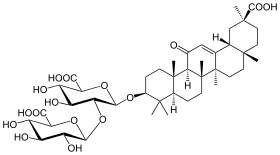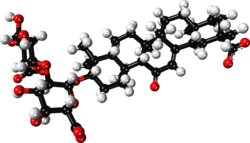Glycyrrhizin
 | |
 | |
| Systematic (IUPAC) name | |
|---|---|
|
(3β,20β)-20-carboxy-11-oxo-30-norolean-12-en-3-yl 2-O-β-D-glucopyranuronosyl-α-D-glucopyranosiduronic acid | |
| Clinical data | |
| Trade names | Epigen, Glycyron |
| AHFS/Drugs.com | International Drug Names |
| Legal status |
|
| Routes of administration | Oral, intravenous |
| Pharmacokinetic data | |
| Metabolism | Hepatic and by intestinal bacteria |
| Biological half-life | 6.2-10.2 hours[1] |
| Excretion | Faeces, urine (0.31-0.67%)[2] |
| Identifiers | |
| CAS Number | 1405-86-3 (α-D-Glucopyranosiduronic acid), 103000-77-7 (β-D-Glucopyranosiduronic acid) |
| ATC code | A05BA08 |
| PubChem | CID 128229 |
| ChemSpider |
14263 |
| UNII | 6FO62043WK |
| ChEBI |
CHEBI:15939 |
| ChEMBL |
CHEMBL441687 |
| Chemical data | |
| Formula | C42H62O16 |
| Molar mass | 822.93 g/mol |
| |
| |
| Physical data | |
| Solubility in water | 1-10 mg/mL (20 °C) |
Glycyrrhizin (or glycyrrhizic acid or glycyrrhizinic acid) is the chief sweet-tasting constituent of Glycyrrhiza glabra (liquorice) root. Structurally it is a saponin and has been used as an emulsifier and gel-forming agent in foodstuff and cosmetics. Its aglycone is enoxolone and it has therefore been used as a prodrug for that compound, for example it is used in Japan to prevent liver carcinogenesis in patients with chronic hepatitis C.[3]
Medical uses
Glycyrrhizin inhibits liver cell injury and is given intravenously for the treatment of chronic viral hepatitis and cirrhosis in Japan.[4][5] It has also proven itself effective in the treatment of autoimmune hepatitis in one clinical trial.[6]
Adverse effects
The most widely reported side effects of glycyrrhizin use are fluid retention. These effects are related to the inhibition of cortisol metabolism within the kidney, and the subsequent stimulation of the mineralocorticoid receptors.[7] Other side effects include:[8]
- Headache
- Paralysis
- Transient visual loss
- Torsades de pointes
- Tachycardia
- Cardiac arrest
- Hypokalaemia
- Reduced testosterone
- Premature birth
- Acute kidney failure
- Muscle weakness
- Myopathy
- Myoglobinuria
- Rhabdomyolysis
- Increased body weight
Mechanism of action
It inhibits the enzyme 11beta-hydroxysteroid dehydrogenase, which likely contributes to its anti-inflammatory and mineralocorticoid activity.[8] It has a broad-spectrum of antiviral activity in vitro against:[8][9]
- Herpes simplex virus,[10] which has also been confirmed in vivo.[11]
- Influenzavirus (including H5N1)[12]
- Varicella zoster virus[13]
- SARS coronavirus
- HIV
- Hepatitis A virus
- Hepatitis B virus
- Hepatitis C virus
- Hepatitis E virus
- Epstein-barr virus
- Human cytomegalovirus
- Flavivirus
- Japanese encephalitis virus
Pharmacokinetics
After oral ingestion, glycyrrhizin is first hydrolysed to 18β-glycyrrhetinic acid by intestinal bacteria. After complete absorption from the gut, β-glycyrrhetinic acid is metabolised to 3β-monoglucuronyl-18β-glycyrrhetinic acid in the liver. This metabolite then circulates in the bloodstream. Consequently its oral bioavailability is poor. The main part is eliminated by bile and only a minor part (0.31–0.67%) by urine.[14] After oral ingestion of 600 mg of glycyrrhizin the metabolite appeared in urine after 1.5 to 14 hours. Maximal concentrations (0.49 to 2.69 mg/l) were achieved after 1.5 to 39 hours and metabolite can be detected in the urine after 2 to 4 days.[14]
Organoleptic properties
It is 30-50 times as sweet as sucrose (table sugar).[8][15]
See also
References
- ↑ van Rossum, TG; Vulto, AG; Hop, WC; Schalm, SW (December 1999). "Pharmacokinetics of intravenous glycyrrhizin after single and multiple doses in patients with chronic hepatitis C infection.". Clinical Therapeutics 21 (12): 2080–90. doi:10.1016/S0149-2918(00)87239-2. PMID 10645755.
- ↑ Ploeger, B; Mensinga, T; Sips, A; Seinen, W; Meulenbelt, J; DeJongh, J (May 2001). "The pharmacokinetics of glycyrrhizic acid evaluated by physiologically based pharmacokinetic modeling.". Drug Metabolism Reviews 33 (2): 125–47. doi:10.1081/DMR-100104400. PMID 11495500.
- ↑ Arase, Yasuji; Ikeda, Kenji; Murashima, Naoya; Chayama, Kazuaki; Tsubota, Akihito; Koida, Isao; Suzuki, Yoshiyuki; Saitoh, Satoshi; Kobayashi, Masahiro; Kumada, Hiromitsu (15 April 1997). "The long term efficacy of glycyrrhizin in chronic hepatitis C patients". Cancer 79 (8): 1494–1500. doi:10.1002/(SICI)1097-0142(19970415)79:8%3C1494::AID-CNCR8%3E3.0.CO;2-B.
- ↑ Sato, H; Goto, W; Yamamura, J; Kurokawa, M; Kageyama, S; Takahara, T; Watanabe, A; Shiraki, K (May 1996). "Therapeutic basis of glycyrrhizin on chronic hepatitis B.". Antiviral Research 30 (2-3): 171–7. doi:10.1016/0166-3542(96)00942-4. PMID 8783808.
- ↑ van Rossum, TG; Vulto, AG; de Man, RA; Brouwer, JT; Schalm, SW (March 1998). "Review article: glycyrrhizin as a potential treatment for chronic hepatitis C." (PDF). Alimentary Pharmacology & Therapeutics 12 (3): 199–205. doi:10.1046/j.1365-2036.1998.00309.x. PMID 9570253. Cite uses deprecated parameter
|coauthors=(help) - ↑ Yasui, S; Fujiwara, K; Tawada, A; Fukuda, Y; Nakano, M; Yokosuka, O (December 2011). "Efficacy of intravenous glycyrrhizin in the early stage of acute onset autoimmune hepatitis.". Digestive Diseases and Sciences 56 (12): 3638–47. doi:10.1007/s10620-011-1789-5. PMID 21681505.
- ↑ Ferrari, P.; Sansonnens, A.; Dick, B.; Frey, F. J. (2001). "In Vivo 11 -HSD-2 Activity: Variability, Salt-Sensitivity, and Effect of Licorice". Hypertension 38 (6): 1330–6. doi:10.1161/hy1101.096112. PMID 11751713.
- 1 2 3 4 Asl, MN; Hosseinzadeh, H (June 2008). "Review of pharmacological effects of Glycyrrhiza sp. and its bioactive compounds." (PDF). Phytotherapy Research 22 (6): 709–24. doi:10.1002/ptr.2362. PMID 18446848.
- ↑ Shamsa, F; Ohtsuki, K; Hasanzadeh, E; Rezazadeh, S (2010). "The Anti-inflammatory and Anti-viral Effects of an Ethnic Medicine: Glycyrrhizin" (PDF). Journal of Medicinal Plants 9 (Suppl. 2): 1389.
- ↑ Pompei, Raffaello; Flore, Ornella; Marccialis, Maria Antonietta; Pani, Alessandra; Loddo, Bernardo (1979). "Glycyrrhizic acid inhibits virus growth and inactivates virus particles". Nature 281 (5733): 689–90. doi:10.1038/281689a0. PMID 233133.
- ↑ Sekizawa, T; Yanagi, K; Itoyama, Y (February 2001). "Glycyrrhizin increases survival of mice with herpes simplex encephalitis.". Acta Virologica 45 (1): 51–4. PMID 11394578.
- ↑ Michaelis, Martin; Geiler, Janina; Naczk, Patrizia; Sithisarn, Patchima; Leutz, Anke; Doerr, Hans Wilhelm; Cinatl, Jindrich (2011). Pekosz, Andrew, ed. "Glycyrrhizin Exerts Antioxidative Effects in H5N1 Influenza a Virus-Infected Cells and Inhibits Virus Replication and Pro-Inflammatory Gene Expression". PLoS ONE 6 (5): e19705. doi:10.1371/journal.pone.0019705. PMC 3096629. PMID 21611183.
- ↑ Baba, M; Shigeta, S (February 1987). "Antiviral activity of glycyrrhizin against varicella-zoster virus in vitro.". Antiviral Research 7 (2): 99–107. doi:10.1016/0166-3542(87)90025-8. PMID 3034150.
- 1 2 Kočevar Glavač, Nina; Kreft, Samo (2012). "Excretion profile of glycyrrhizin metabolite in human urine". Food Chemistry 131: 305–308. doi:10.1016/j.foodchem.2011.08.081.
- ↑ "Glycyrrhizic Acid". PubChem. National Institutes of Health. Retrieved 24 February 2014.
External links
- CHEMICAL MODIFICATION OF GLYCYRRHIZIC ACID AS A ROUTE TO NEW BIOACTIVE COMPOUNDS FOR MEDICINE by L.A.Baltina; doi:10.2174/0929867033368538
| ||||||||||||||||||
| ||||||||||
| ||||||||||||||||||||||||||||||||||||||||||||||||||||||